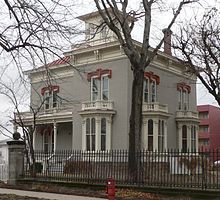From Wikipedia....
Prior to the expansion westward of settlers, the prairie was covered
with buffalo grass. Plains Indians, descendants of indigenous peoples
who occupied the area for thousands of years, lived in and hunted along
Salt Creek. The Pawnee, which included four tribes, lived in villages
along the Platte River. The Great Sioux Nation, including the
Ihanktowan-Ihanktowana and the Lakota located to the north and west,
used Nebraska as a hunting and skirmish ground, although they did not
have any long-term settlements in the state. An occasional buffalo could
still be seen in the plat of Lincoln in the 1860s.
.jpg)
Lincoln was founded in 1856 as the village of Lancaster and
became the county seat of the newly created Lancaster County in 1859.
The village was sited on the east bank of Salt Creek. The first settlers
were attracted to the area due to the abundance of salt. Once J.
Sterling Morton developed his salt mines in Kansas, salt in the village
was no longer a viable commodity.
Captain W. T. Donovan, a former steamer captain, and his family settled
on Salt Creek in 1856. In the fall of 1859, the village settlers met to
form a county. A caucus was formed and the committee, which included
Captain Donovan, selected the village of Lancaster to be the county
seat. The county was named Lancaster. After the passage of the 1862
Homestead Act, homesteaders began to inhabit the area. The first plat
was dated August 6, 1864.
By the close of 1868, Lancaster had a population of approximately 500
people. The township of Lancaster was renamed Lincoln with the
incorporation of the city of Lincoln on April 1, 1869. In 1869, the
University of Nebraska was established in Lincoln by the state with a
land grant of about 130,000 acres. Construction of University Hall, the
first building, began the same year.
The capital of the Nebraska Territory had been Omaha since the
creation of the territory in 1854; however, most of the territory's
population lived south of the Platte River. After much of the territory
south of the Platte River considered annexation to Kansas, the
territorial legislature voted to locate the capital city south of the
river and as far west as possible.
 |
Thomas P. Kennard House
Prior to the vote to remove the capital city from Omaha, a last
ditch effort by Omaha Senator J. N. H. Patrick attempted to
derail the moves by having the future capital city named after
recently assassinated President Abraham Lincoln. Many of
the people south of the Platte River had been sympathetic to the
Confederate cause in the recently concluded Civil War. It
was assumed that senators south of the river would not vote to
pass the measure if the future capital was named after the
former president. In the ed, the motion to name the future
capital city Lincoln was ineffective and the vote to change the
capital's location south of the Platte River was successful with
the passage of the Removal Act.
Nebraska was granted statehood on March 1, 1867. The Removal Act
called for the formation of a Capital Commission to locate a
site for the capital on state owned land. The Commission,
composed of Governor David Butler, Secretary of State Thomas
Kennard and Auditor John Gillespie, began to tour sites on July
18, 1867 for the new capital city. The village of Lancaster was
chosen, in part due to the salt flats and marshes. Lancaster had
approximately 30 residents. Disregarding the original plat of
the village of Lancaster, Thomas Kennard platted Lincoln on a
broader scale. The plat of the village of Lancaster was not
dissolved nor abandoned; Lancaster became Lincoln when the
Lincoln plat files were finished September 6, 1867. To raise
money for the construction of a capital city, a successful
auction of lots was held. Newcomers began to arrive and
Lincoln's population grew. The Nebraska State Capitol was
completed on December 1, 1868; a two story building constructed
with native limestone with a central cupola. The Kennard house,
built in 1869, is the oldest remaining building in the original
plat of Lincoln. |
Goodhue-designed Nebraska State Capitol.
In 1888 a new capitol building was constructed on the site of the
first capitol. The new building replaced the former structurally unsound
capitol. The second capitol building was a classical design, designed by
architect William H. Willcox. Construction began on a third capitol
building in 1922. Bertram G. Goodhue was selected in a national
competition as its architect. By 1924, the first phase of construction
was completed and state offices moved into the new building. In 1925,
the Willcox designed capitol building was razed. The Goodhue designed
capitol was constructed in four phases, with the completion of the
fourth phase in 1932. The completion of the original Goodhue design will
be finally realized with the completion of the capitol fountains within
the four interior courtyards of the capitol building in 2017.

Government Square; U.S. Post Office and Courthouse (1879-1906); City
Hall (1906-1969)
The worldwide economic depression of 1890 saw the reduction of
Lincoln's population from 55,000 to 37,000 by 1900. Volga-German
immigrants from Russia settled in the North Bottoms neighborhood and
as Lincoln expanded with the growth in population, the city began to
annex towns nearby. The first town annexed was Bethany Heights in
1922. Bethany Heights was incorporated in 1890. In 1929, the city
annexed the town College View. College View was incorporated in
1892. Union College, a Seventh Day Adventist institution, was
founded in College View in 1891. In 1930, the city annexed the town
of Havelock. Havelock actively opposed annexation to Lincoln and
only relented due to a strike by the Burlington railroad shop
workers which halted progress & growth for the city.
The Burlington & Missouri River Railroad's first train arrived in
Lincoln on June 26, 1870, soon to be followed by the Midland Pacific in
1871 and the Atchison & Nebraska in 1872. The Union Pacific began
service in 1877. The Chicago & North Western and Missouri Pacific began
service in 1886. The Chicago, Rock Island & Pacific extended service to
Lincoln in 1892. Lincoln became a rail center hub.
Lincoln is located at
40°48′38″N 96°40′49″W. According to the United States
Census Bureau, in 2014, the city has a total area of 91.77 square
miles (237.68 km), of which, 90.42 square miles (234.19 km) of it is
land and 1.35 square miles (3.50 km) is water.
Lincoln is one of the few large cities of Nebraska not located along
either the Platte River or the Missouri River. The city was originally
laid out near Salt Creek and among the nearly flat saline wetlands of
northern Lancaster County. The city's growth over the years has led to
development of the surrounding land, much of which is composed of gently
rolling hills. In recent years, Lincoln's northward growth has
encroached on the habitat of the endangered Salt Creek tiger beetle.
|

